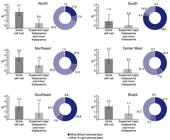ABSTRACT:
Objective:
To describe the prevalence of hemoglobinopathies in the Brazilian adult population, according to laboratory tests from the National Health Survey.
Methods:
A descriptive study was carried out with National Health Survey laboratory data collected between 2014 and 2015. The hemoglobinopathies test was performed using the High Performance Liquid Chromatography method. The results of the individual tests were interpreted as providing normal, homozygous or heterozygous results for S, C and D hemoglobin, in addition to other possible hemoglobinopathies. Prevalence of hemoglobinopathies according to gender, skin color, region, age and schooling was estimated.
Results:
Hemoglobinopathies were present in 3.7% of the population. The main ones were the sickle cell trait (2.49%), thalassemia minor (0.30%) and suspected thalassemia major (0.80%). In relation to the sickle cell trait and suspected thalassemia major, there was a statistically significant difference for the skin color variable (p<0.05). The prevalences found for sickle cell trait according to skin color was: 4.1% among dark-skinned blacks, 3.6% among light-skinned blacks, 1.2% among whites, and 1.7% among others.
Conclusion:
The most prevalent hemoglobinopathies were the sickle cell trait and minor thalassemia, and were predominate among light- and dark-skinned black people. The study helps in identifying hemoglobinopathies and in genetic counseling in pre-conception.
Keywords:
Sickle cell anemia; Sickle cell trait; beta-Thalassemia; Hemoglobin C; Fetal hemoglobin; Neonatal screening
 Thumbnail
Thumbnail
 Sickle cell trait: p = 0.106; suspected major thalassemia and minor thalassemia: p = 0.195.
Sickle cell trait: p = 0.106; suspected major thalassemia and minor thalassemia: p = 0.195.